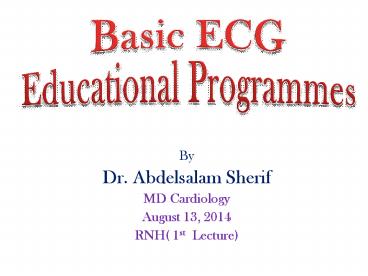Basic ECG 1 - PowerPoint PPT Presentation
Title:
Basic ECG 1
Description:
ECG ( electrocardiogram ) is very important tool in evaluation of cardiovascular diseases, so in this first presentation I focus on some basics in ECG interpretations – PowerPoint PPT presentation
Number of Views:2081
Title: Basic ECG 1
1
Basic ECGEducational Programmes
- By
- Dr. Abdelsalam Sherif
- MD Cardiology
- August 13, 2014
- RNH( 1st Lecture)
2
QUICK REVIEW OF HEART
- Purpose
- Pumps blood
- Basic Anatomy
- 4 chambers
- 2 sides
- 4 valves
3
THE CONDUCTING SYSTEM
- SA Node
- Inter-nodal pathway
- AV Node
- Bundle of HIS
- Bundle Branches
- Purkinje Fibers
4
RELATIONSHIP
5
Relationship
6
Activation Of The Heart
SA Node Normal Pacemaker
Hold It !
7
P
QRS
T
PQ
ST
PR interval
QT interval
8
(No Transcript)
9
Time
0.2 sec
0.04 sec
1 sec
10
Time
0.1 mV
0.2 seconds
1 milliVolt
Voltage
11
Cardiac Cycles
12
HOOKING UP THE 12-LEAD ECG
- Proper skin prep
- Placement of the limb electrodes
- Placement of the chest electrodes
13
ELECTRODE PLACEMENT
- LIMB LEADS
- CHEST LEADS
14
LIMB LEADS
- Bipolar leads
- I, II, III
- Augment leads
- AVR, AVl, AVF
15
RULING OUT LIMB LEAD REVERSAL
- AVR is always negative
- Lead I is always positive
- Lead II and III positive for the P wave and
usually the QRS complex
16
Chest Leads
17
CHEST LEADS
- 6 UNIPOLAR LEADS
- V1
- V2
- V3
- V4
- V5
- V6
18
CHEST LEADS
- CHEST LEADS
- COLUMN III
- R wave progression
- Small to Tall
- COLUMN IV
- R wave progression
- Tall to Small
19
(No Transcript)
20
Some Problems With The ECG
- Artifact
- Electrical interference
- Somatic tremor
- Wandering baseline
21
ARTIFACT ON THE ECG
22
THE ARTEFACT
23
BASELINE WANDERING
24
SOMATIC TREMOR
25
ELECTRICAL INTERFERANCE
26
(No Transcript)
27
Method" of ECG Interpretation
- 1. Measurements.
- 2. Rhythm Analysis.
- 3. Conduction Analysis.
- 4. Waveform description.
- 5. ECG interpretation.
- 6. Comparison with previous ECG ( if any ).
28
Determination OF Heart Rate
29
1st Method
30
2nd Method
31
2nd Method
32
Determination Of QRS axis
33
EINTHOVENS TRIANGLE
34
QRS Axis Determination
35
Axis in Normal range
36
Left Axis Deviation
37
Right Axis Deviation
38
Thanks































